|
|
|
|
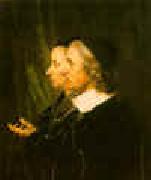 |
Jan de Bray
|
|
1627-1697 Dutch
Painter, draughtsman and etcher, son of (1) Salomon de Bray. He spent virtually the whole of his career in Haarlem, except for the period 1686-8, when he lived in Amsterdam. After training with his father, Jan began working as a portrait painter in Haarlem in 1650, an activity he continued for the next 40 years. Between 1667 and 1684 he served on the committee for the Haarlem Guild of St Luke, whose leading members he portrayed in a picture dated 1675 (Amsterdam, Rijksmus.) that includes a self-portrait (Jan is seen standing and drawing on the left). He married three times, in 1668, 1670 and 1672. His first two wives died a year after their marriage, his third two years afterwards, and in each case the death was followed by disputes over the inheritance. Jan bankruptcy of 1689 may have been a result of one of the lawsuits. He was 62 at the time, and from then onwards he seems to have lost his artistic drive, crushed by the financial blow and the consequent loss of social position. |
|
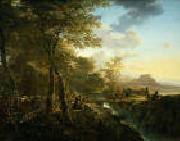 |
Jan Dirksz Both
|
|
Dutch
1610-1652
Jan Dirksz Both (between 1610 and 1618, Utrecht - Aug 9 1652, Utrecht), brother of Andries Both, was a Dutch painter.
From 1634 to 1637 he was taught by Bloemaert and the painter Gerard van Honthorst before travelling to Rome ca. 1637. There he met the French painter Claude Lorrain, with whom he collaborated on a series of landscape paintings. His landscapes are typically peopled by peasants driving cattle or travellers gazing on Roman ruins in the light of the evening sun The everyday life of the streets of Rome became a favourite theme in his works. On his return to Utrecht after the death of his brother in 1642, he stopped producing genre pieces and focused instead on pictures of Italian landscapes bathed in a warm, golden light. This theme was adopted by several other Dutch painters, the Italianites.
|
|
 |
Jan Frans van Dael
|
|
an excellent painter of fruit and flowers, was born at Antwerp in 1764, but went early to Paris and settled there. He was self-inatructed in art, but made such progress that he soon distinguished himself at the exhibitions, on one occasion obtaining the prize of 4000 francs, and on two others, the large gold medal. His style is in the manner of Van Huysum and Van Spaendonck, although he did not confine himself strictly to fruit and flowers, but painted other subjects, in which such objects might with propriety be introduced. Two of his pictures, which he painted for the Empress Josephine, represent 'An Offering to Flora,' and 'The Tomb of Julia'; the latter is now in the Louvre. His master-piece, known as 'La Croisee,' the fruit of three years' labour, was likewise purchased by the Empress Josephine, and is now in a private collection at Liege. He was also patronized by the Empress Marie Louise, who took one of his pictures with her to Parma. He died in Paris in 1840, and was buried in the cemetery of Pere Lachaise by the side of his friend Van Spaendonck. The Louvre has also by him three pictures of 'Flowers' and one of 'Fruit.' |
|
|
|
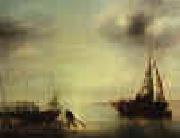 |
Jan van de Cappelle
|
|
1624-1679
Dutch Jan van de Cappelle Locations
Dutch businessman, collector, painter, draughtsman and etcher. Though now considered the outstanding marine painter of 17th-century Holland, he was not a professional artist nor a member of the Amsterdam Guild of St Luke. His father owned a successful dye-works in Amsterdam, in which both Jan and his brother Louis were active. Their father enjoyed a long life and probably managed the firm until close to his death in 1674, when Jan inherited it. This left Jan with plenty of spare time to pursue his hobby, painting. He married Annetje Jansdr. (Anna Grotingh) before 1653. He died a widower, survived by his seven children, who inherited his considerable fortune. His last will shows that in addition to the dye-works and immense cash assets, van de Cappelle owned extensive properties and an art collection that must be rated among the most important of his time. |
|
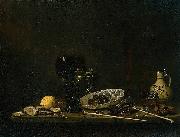 |
Jan van de Velde
|
|
(1593, Delft or Rotterdam-ca. 1 November 1641, Enkhuizen) was a Dutch Golden Age painter and engraver of animal, landscape and still-life subjects. He was the father of the still life painter Jan Jansz van de Velde.
He was apprenticed to engraver Jacob Matham in 1613, entered the Haarlem guild in 1614, and then probably visited Italy. He is better known for his etching and engraving than for his painting. According to Houbraken, he was the brother of Esaias van de Velde and Willem van de Velde the Elder, but according to John Denison Champlin, Esaias was his cousin, and he was no relation at all to the family of Willem. |
|
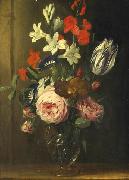 |
Jan van den Hecke
|
|
(1620-1684) was a Flemish Baroque painter.
According to Houbraken he painted landscapes, which he populated with animals and other figures himself. He also made flower and fruit still lifes and could paint gold, silver, crystal, and porcelain quite well. He spent a long period travelling and working in Italy, which is noticeable in his landscapes.
According to the RKD he was registered in the Antwerp Guild of Saint Luke as an apprentice in 1636 and learned to paint from Abraham Hack, who also taught his contemporary, the flower painter Hieronymus Galle. In 1641 Van den Hecke was registered as a master of the guild. From 1653-1658 he was in Italy, but somewhere in the mid-50's he went back and forth to Belgium, since he is also registered in Brussels during that period. He died the same year as his wife Maria Adriana Heijens; when they died they left three children; Jan (II), aged 24, Maria, aged 21, and Peeter, aged 20. Van den Hecke's pupil Peeter de Clerc eventually became a master painter in the guild. Van den Hecke's son Jan van den Hecke II became a popular flower painter. |
|
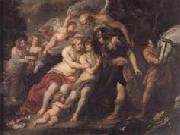 |
Jan Van Den Hoecke
|
|
Flemish Baroque Era Painter, 1611-1651
was a Flemish Baroque painter and draughtsman. He was born and died in Antwerp. He first apprenticed with his father, the painter Gaspar van den Hoecke (1595?C1648); then worked in the studio of Peter Paul Rubens. Jan's brother Robert van den Hoecke (1622?C1668) was also a painter. The artist and his father were well known for their 1635 execution of decorations for the Arch dedicated to the Emperor Ferdinand III in Antwerp. In this collaboration, Jan painted monumental representations, as seen in his piece, Triumphal Entrance of Cardinal Prince Ferdinand of Spain, (Uffizi Gallery). Hoecke then traveled to Austria under the commission of the Emperor Ferdinand III after 1637, staying for about ten years. He also painted for Ferdinand's brother, Archduke Leopold Wilhelm of Austria (1614-C1662), including a Madonna and Child and a number of allegorical pieces. Before this he traveled to Italy and worked in Rome, which may have influenced his style some. Another piece by Hoecke is his, Hercules between Vice and Virtue, (Uffizi Gallery), which shows an influence from both Rubens, and another pupil of the master Baroque painter, Anthony van Dyck. |
|
 |
Jan van der Heyden
|
|
1637-1712
Dutch
Jan Van Der Heyden Gallery
Van der Heyden grew up in Gorcum, but the family moved to Amsterdam around 1650. They lived on Dam Square. As a young guy he witnessed the fire in the old townhall which made a deep impression on him. He later would describe or draw 80 fires in almost any neighborhood of Amsterdam. When he married in 1661 the family was living on Herengracht, the most fashionable canal in Amsterdam. In 1668 Cosimo II de' Medici bought one of his paintings, a view of the townhall with a manipulated perspective. Van der Heyden often painted country estates, like Goudestein, owned by Joan Huydecoper II. He was not good in drawing figures and used for his paintings a metal plate for bricks, a sponge or moss for the leaves. Johannes Lingelbach, Adriaen van de Velde und Eglon van der Neer assisted him drawing the figures. Jan van der Heyden also introduced the lamp post and in 1672 impoved the design of the fire engine. He died in wealth as the superintendent of the lighting and director of the (voluntary) firemen's guild at Amsterdam.
Van der Heyden was a contemporary of the landscape painters Hobbema and Jacob van Ruisdael, with the advantage, which they lacked, of a certain professional versatility; for, whilst they painted admirable pictures and starved, he varied the practice of art with the study of mechanics. Until 1672 he painted in partnership with Adriaen van de Velde. After Adrian's death, and probably because of the loss which that event entailed upon him, he accepted the offices to which allusion has just been made. At no period of artistic activity had the system of division of labour been more fully or more constantly applied to art than it was in Holland towards the close of the 17th century.
Van der Heyden, who was perfect as an architectural draughtsman insofar as he painted the outside of buildings and thoroughly mastered linear perspective, seldom turned his hand to the delineation of anything but brick houses and churches in streets and squares, or rows along canals, or "moated granges," common in his native country.
He was a travelled man, had seen The Hague, Ghent and Brussels, and had ascended the Rhine past Xanten to Cologne, where he copied over and over again the tower and crane of the great cathedral. But he cared nothing for hill or vale, or stream or wood. He could reproduce the rows of bricks in a square of Dutch houses sparkling in the sun, or stunted trees and lines of dwellings varied by steeples, all in light or thrown into passing shadow by moving cloud.
He had the art of painting microscopically without loss of breadth or keeping. But he could draw neither man nor beast, nor ships nor carts; and this was his disadvantage. His good genius under these circumstances was Adrian van der Velde, who enlivened his compositions with spirited figures; and the joint labour of both is a delicate, minute, transparent work, radiant with glow and atmosphere. |
|
|
|
 |
Jan Van Dornicke
|
|
was a South Netherlandish painter who was born about 1470 and died about 1527. His first name is sometimes spelled Janssone, and his last name is sometimes spelled van Doornik or van Dornick. He was active in Antwerp from about 1509 to about 1525. His paintings are classified stylistically as Antwerp Mannerism, and he may be the same person as the Master of 1518. |
|
 |
Janos Donat
|
|
1744-1830
Hungarian
Janos Donat Location
Donat was born in Klosterneuzell in 1744 and learned painting at M. Meytens, V. Fischer and Sambach in Vienna where he lived for some time and later Prague. In Vienna he became interested in painting portraits. After moving to Pest in 1810 he painted some of his most noted classicist portraits such as Ferenc Kazinczy in 1812 and Benedek Virag in 1815.
He was also noted for his compositions such as Resting Venus, Orfeus and Euridike, and Proserpina which were paintings of mythological creatures. |
|
 |
Jean Auguste Dominique Ingres
|
|
J. A. D. Ingres (1780-1867)
was born in Montauban on August 29, 1780, the son of an unsuccessful sculptor and painter. French painter. He was the last grand champion of the French classical tradition of history painting. He was traditionally presented as the opposing force to Delacroix in the early 19th-century confrontation of Neo-classicism and Romanticism, but subsequent assessment has shown the degree to which Ingres, like Neo-classicism, is a manifestation of the Romantic spirit permeating the age. The chronology of Ingres's work is complicated by his obsessive perfectionism, which resulted in multiple versions of a subject and revisions of the original. For this reason, all works cited in this article are identified by catalogue. |
|
|
|
|
|
|
|
|
|
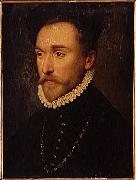 |
Jean Decourt
|
|
Jean de Court, an enamel painter of Limoges, succeeded François Clouet as painter to the king in 1572, and was in turn succeeded by his son, Charles de Court, in 1584 or 1589. Jean de Court painted in 1574 a portrait of Henry III, then Duke of Anjou. |
|
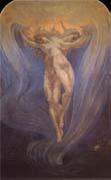 |
Jean Delville
|
|
Belgian Symbolist Painter, 1867-1953
Belgian painter, decorative artist and writer. He studied at the Academie Royale des Beaux-Arts, Brussels, with Jean-Franeois Portaels and the Belgian painter Joseph Stallaert (1825-1903). Among his fellow students were Eugene Laermans, Victor Rousseau and Victor Horta. From 1887 he exhibited at L Essor, where in 1888 Mother (untraced), which depicts a woman writhing in labour, caused a scandal. Although his drawings of the metallurgists working in the Cockerill factories near Charleroi were naturalistic, from 1887 he veered towards Symbolism: the drawing of Tristan and Isolde (1887; Brussels, Musees Royaux B.-A.), in its lyrical fusion of the two bodies, reveals the influence of Richard Wagner. Circle of the Passions (1889), inspired by Dante Alighieri Divina commedia, was burnt c. 1914; only drawings remain (Brussels, Musees Royaux B.-A.). Jef Lambeaux copied it for his relief Human Passions (1890-1900; Brussels, Parc Cinquantenaire). Delville became associated with Josephin Peladan, went to live in Paris and exhibited at the Salons de la Rose+Croix, created there by Peladan (1892-5). A devoted disciple of Peladan, he had his tragedies performed in Brussels and in 1895 painted his portrait (untraced). He exhibited Dead Orpheus (1893; Brussels, Gillion-Crowet priv. col.), an idealized head, floating on his lyre towards reincarnation, and Angel of Splendour (1894; Brussels, Gillion-Crowet priv. col.), a painting of great subtlety. |
|
|
|
 |
Jean Francois de troy
|
|
French Neoclassical Painter, 1679-1752
was a French Rococo painter and tapestry designer. He was one of a family of painters, being the son of the portrait painter François de Troy (1645-1730), under whom he first studied, and at whose expense he went to Italy 1699-1706, staying in Rome, but also visiting many north Italian cities. Jean François de Troy was born on January 27, 1679 in Paris. The successful career of Jean François de Troy was based initially on large historical and allegorical compositions, such as Time Unveiling Truth (1733) in the National Gallery, London, but he is now most highly regarded for his smaller and more spirited scenes of elegant social life. They are among the best of those that rode on the wave of Watteau's success indeed The Alarm, or the Gouvernante Fidele (Victoria and Albert Museum, London, 1723) was attributed to Watteau in the 19th century. A versatile artist, he made tableaux de modes famous, painting histories and mythologies in a colourful and fluent manner which owed something to both Veronese and Peter Paul Rubens. He undertook commissions for Versailles and Fontainebleau between 1724 and 1737, and designed two sets of tapestries for the Gobelins, each of seven subjects, the Histoire d'Esther (1737-40) and the Histoire de Jason (1743-6). |
|
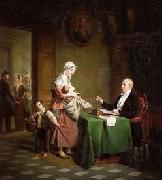 |
Jean Henri De Coene
|
|
Jean Henri De Coene, a Belgian painter of genre and historical subjects, was born at Nederbrakel in 1798. |
|
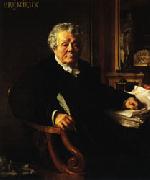 |
Jean Lecomte Du Nouy
|
|
French Painter and Sculptor, 1842-1923,was an orientalist French painter and sculptor. He was Charles Gleyre's and Jean-Leon G??rome's pupil. A Paris street was named after him in 1932. |
|
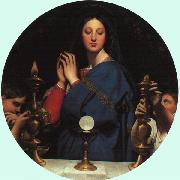 |
Jean-Auguste Dominique Ingres
|
|
French Neoclassical Painter, 1780-1867
was a French Neoclassical painter. Although he considered himself a painter of history in the tradition of Nicolas Poussin and Jacques-Louis David, by the end of his life it was Ingres' portraits, both painted and drawn, that were recognized as his greatest legacy.
A man profoundly respectful of the past, he assumed the role of a guardian of academic orthodoxy against the ascendant Romantic style represented by his nemesis Eug??ne Delacroix. His exemplars, he once explained, were "the great masters which flourished in that century of glorious memory when Raphael set the eternal and incontestable bounds of the sublime in art ... I am thus a conservator of good doctrine, and not an innovator." Nevertheless, modern opinion has tended to regard Ingres and the other Neoclassicists of his era as embodying the Romantic spirit of his time, while his expressive distortions of form and space make him an important precursor of modern art.. |
|
 |
Jean-Auguste-Dominique Ingres
|
|
1780-1867
French painter. He was the last grand champion of the French classical tradition of history painting. He was traditionally presented as the opposing force to Delacroix in the early 19th-century confrontation of Neo-classicism and Romanticism, but subsequent assessment has shown the degree to which Ingres, like Neo-classicism, is a manifestation of the Romantic spirit permeating the age. The chronology of Ingres's work is complicated by his obsessive perfectionism, which resulted in multiple versions of a subject and revisions of the original. |
|
 |
Jean-Baptiste Deshays
|
|
French Baroque Era Painter, 1729-1765
was a French painter of religious and mythological subjects.His first training was under his father, the minor Rouen painter Jean-Dominique Deshays, he then spent a little time under Jean-Baptiste Descamps at his Ecole Gratuite de Dessin. He spent time in Hyacinthe Collin de Vermont's Paris studio from around 1740 to 1749 and Jean Restout II's from late 1749 to 1751. Both these had been pupils of Jean Jouvenet, and painted in the Grand Style of French history painting, a style Deshays adopted as his own. While he was in Restout's studio, Deshays entered the Prix de Rome competition, winning second prize in 1750 with His 1750 Laban Giving his Daughter in Marriage to Jacob won the second prize in the Grand Prix de Rome, and his 1751 Job on the Dung-hill the first prize. Deshays served the compulsory three years training at the Ecole des Eleves Prot??g??s (where he learnt from Carle van Loo, its director, and attracted some religious commissions, including two vast canvases, a Visitation and an Annunciation, for the monastery of the Visitation at Rouen), before going to Rome. |
|
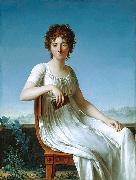 |
Jean-Baptiste Francois Desoria
|
|
Jean-Baptiste François Desoria (1758-1832).
Both once enjoyed considerable renown among the elite of the Paris Enlightenment; today their names are barely known. Jean-Baptiste François Desoria (1758-1832), born in Paris, was, with the exception of some portraiture, primarily a history painter in the Neo-Classical style of his slightly older contemporary, Jacques-Louis David. Constance Pipelet, born in Nantes in 1767, was a surgeon's wife (later divorced) turned writer and librettist; she was noted primarily for her opera Sapho and her Epître aux femmes ( Epistle to the Women). Like her French predecessor of some four centuries earlier, Christine de Pizan, Constance Pipelet celebrated in writing the intellectual achievements of women. |
|
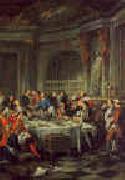 |
Jean-Francois De Troy
|
|
French
1679-1752
Jean-Francois
De Troy Gallery
Jean François de Troy was born on January 27, 1679 in Paris. The successful career of Jean François de Troy was based initially on large historical and allegorical compositions, such as Time Unveiling Truth (1733) in the National Gallery, London, but he is now most highly regarded for his smaller and more spirited scenes of elegant social life. They are among the best of those that rode on the wave of Watteau's success??indeed The Alarm, or the Gouvernante Fid??le (Victoria and Albert Museum, London, 1723) was attributed to Watteau in the 19th century. A versatile artist, he made tableaux de modes famous, painting histories and mythologies in a colourful and fluent manner which owed something to both Veronese and Peter Paul Rubens.
He undertook commissions for Versailles and Fontainebleau between 1724 and 1737, and designed two sets of tapestries for the Gobelins, each of seven subjects, the Histoire d'Esther (1737-40) and the Histoire de Jason (1743-6).
In 1738 he was appointed Director of the French Academy in Rome, and spent the rest of his life there. De Troy's wife died prematurely, and he lost of all his seven children. Jean François de Troy died on January 26, 1752 in Rome. |
|
 |
Jean-Germain Drouais
|
|
1763-1788
French
Jean Germain Drouais Locations
Son of Francois-Hubert Drouais. He trained first with his father and in 1778 enrolled at the Academie Royale, becoming a pupil of Nicolas-Guy Brenet. Around 1781 he entered Jacques-Louis David studio as one of his first pupils. The following year, though not officially entered for the competition, he painted that year Prix de Rome subject, the Return of the Prodigal Son (Paris, St Roch), presumably as a trial for his own edification. The picture has a friezelike composition and reveals both the influence of Jean-Francois Peyron and David as well as debts to Poussin and Italian 17th-century sources. In 1783 Drouais reached the Prix de Rome final with the Resurrection of the Son of the Widow of Nain (Le Mans, Mus. Tesse) but was eliminated from the competition in extraordinary circumstances: impatient to know his master opinion, Drouais cut a section off the canvas and smuggled it out of the competition rooms. David acknowledged it to be the best thing his favourite pupil had yet done, but by his hasty action Drouais had disqualified himself. However, the following year he won the prize, and great acclaim, with the Woman of Canaan at the Feet of Christ (Paris, Louvre), an extremely accomplished piece influenced by Poussin work and David Belisarius (Lille, Mus. B.-A.). |
|
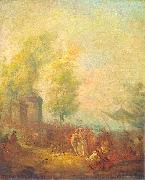 |
Jean-Pierre Norblin de La Gourdaine
|
|
(in Polish, Jan Piotr Norblin; 15 July 1745 - 23 February 1830) was a French-born painter, draughtsman, engraver, drawing artist and caricaturist. From 1774 to 1804 he resided in the Polish-Lithuanian Commonwealth, where he obtained citizenship.
He is considered one of the most important painters of the Polish Enlightenment. He achieved great success in Poland. Given many commissions from some of the most notable families of the Polish-Lithuanian Commonwealth, he stayed there for many years, not returning to Paris until the early 19th century. His style showed the influence of Antoine Watteau, and combined the Rococo tradition of charming fates galantes and fetes champetres with a panorama of daily life and current political events, captured with journalistic accuracy. He created a gallery of portraits of representatives of all social classes in the last years of the Polish-Lithuanian Commonwealth.
|
|
 |
Jeronymus van Diest
|
|
(1631, The Hague - ca.1687, The Hague), was a Dutch Golden Age seascape painter.
According to Houbraken, a Jeronymus van Diest was good with grisailles and was the teacher of Adriaen van de Venne.[1] This grisaille painter Jeronymus Diest (I) may possibly have been a grandfather of the younger Jeronymus Diest (II); since they are both from the Hague.
According to the RKD this younger Jeronymus Diest (II) was the son of the painter Willem van Diest and the father of the painter Adriaen van Diest who was a follower of Jan van Goyen and Hendrik Dubbels.His known works are all seascapes with various ships at sail. |
|
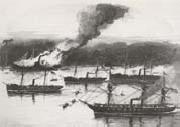 |
Jo Davidson
|
|
American Sculptor, 1883-1952,was an American sculptor of Russian-Jewish descent. Although he specialized in realistic, intense portrait busts, Davidson did not require his subjects to formally pose for him; rather, he observed and spoke with them. He worked primarily with clay, while the final products were typically cast in terra-cotta, marble and bronze. Born in New York City, Davidson attended Yale University before moving to Paris to study sculpture at Ecole nationale superieure des beaux arts in 1907. After returning to the United States, he was befriended by Gertrude Vanderbilt Whitney, who purchased some of Davidson's work. In 1911 Davidson secured his first solo gallery shows; in 1934 he won the National Academy of Design Maynard Prize, and in 1947 the American Academy of Arts and Letters hosted a retrospective featuring nearly 200 of his works. He was one of 250 sculptors who exhibited in the 3rd Sculpture International held at the Philadelphia Museum of Art in the summer of 1949. Among Davidson commissions are a design for a United States War Industries badge, a collection of pieces for the Government of France to commemorate the first victory of the Troupes de Marine and bronze busts of the leaders of the Allies. His portraits of world leaders and celebrated personalities gained him international acclaim, and included such luminaries as Woodrow Wilson, Franklin Delano Roosevelt, Rudyard Kipling, James Joyce, Gertrude Stein, Andrew Mellon, Will Rogers, John D. Rockefeller, Joseph Conrad, Anatole France, Lincoln Steffens, Gertrude Vanderbilt Whitney, Marshall Ferdinand Foch, General John J. Pershing, John Marin, Rabindranath Tagore, Frank Harris, Israel Zangwill, Charlie Chaplin, Robert M. La Follette, Clarence Darrow, Emile Coue (who was also a sculptor in his spare time), H. G. Wells, Robinson Jeffers, Andre Gide. George Bernard Shaw, James Barrie, Arthur Conan Doyle,D. H. Lawrence, W. Averell Harriman, Madame Chiang Kai shek, Dolores Ibarruri, aka La Passionaria, Helen Keller, Mahatma Gandhi, Dwight D. Eisenhower, Ida Rubinstein, Albert Einstein, Carl Sandburg, Marshall Tito, E. W. Marland and Walt Whitman. Will Rogers statue is a full-body bronze portrait erected at the United States Capitol in 1939. Walt Whitman portrait is also a full-body bronze, and stands in Bear Mountain State Park, New York. Some of Davidson's work is in the National Gallery of Art and in the Capitol Building where he has placed two works, Will Rogers of Oklahoma and Robert M. La Follette of Wisconsin in the National Statuary Hall, and busts of two vice presidents, Henry A. Wallace and Charles G. Dawes, all of which are located in Washington, D.C.. He also designed a statue of Henry D. Thoreau, the author of WALDEN. The statue is located at Walden Pond State Reservation in Concord, MA. In 2006, The Smithsonian Institution's National Portrait Gallery opened a permanent exhibition, Jo Davidson: Biographer in Bronze, showcasing fourteen Davidson works in terracotta and bronze, including portraits of Gertrude Stein and Lincoln Steffens. |
|
|
|
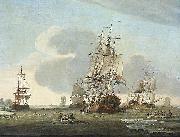 |
Jochem de Vries
|
|
painted The Zaandam shipping company Claes Tan en Zns Greenland farer Zaandam whaling in 1772
|
|
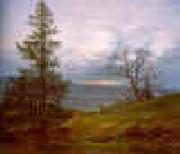 |
Johan Christian Dahl
|
|
1788-1857
Norwegian
1857). Norwegian painter and collector, active in Germany. His paintings, imbued with Romantic and patriotic sentiments, had a strong influence on the landscape tradition both in Germany (especially Dresden) and in his native Norway. |
|
|
|
|
|
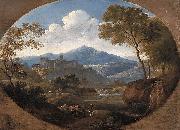 |
Johann Georg von Dillis
|
|
(born Gmain, December 26, 1759 - died Munich, September 28, 1841) was a German painter. Son of a gamekeeper and forester, he was educated in Munich with support from the prince-elector of Bavaria. Initially he was trained for the priesthood, but by 1786 his real interest, art, was beginning to be developed, and he taught drawing both at court and to private families. In 1790 he was appointed inspector of the Hofgarten Galerie, the princely collection. He continued in a curatorial role for the Bavarian court for much of the rest of his career; this allowed him some freedom to travel and expand his knowledge of European art. In 1792 he traveled to Dresden, Prague, and Vienna, and in 1794 he made his first trip to Italy, where he made watercolor studies from nature. A further trip to Italy followed in 1805, and brought him to Rome, where he met Pierre-Henri de Valenciennes, who introduced him to the idea of painting in open air. He studied the work of Simon Denis and Joseph Mallaord William Turner, and encountered Washington Allston. The next year, in Paris, he saw oil sketches by Jean-Joseph-Xavier Bidauld, and with Ludwig, the crown prince visited the Musee Napoleon; he would later advise the prince on collecting and other matters artistic, remaining in this capacity for the rest of his life. He also made several trips to Italy to purchase art for the royal collection. In 1816 he was made responsible for packing and returning to Munich from Paris art stolen from Bavaria by Napoleon. In the fall of 1817 he and Ludwig traveled to Sicily before spending four months in Rome. Dillis helped to shape the collections of the Alte Pinakothek, which opened in 1836. He died in Munich in 1841.
|
|
|
|
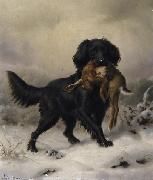 |
Johannes Deiker
|
|
painted Schwarzer Setter apportiert Hasen in winterlicher Landschaft in 1886
1822-1895 |
|
|
|
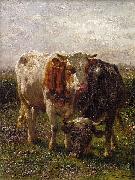 |
Johannes Hubertus Leonardus de Haas
|
|
(25 March 1832 - 4 August 1908) was a Dutch animal and landscape painter, and a peripheral figure of the Hague School.
Born at Hedel, De Haas spend his youth in Amsterdam where he got his first art education at evening-classes at the Koninklijke Academie. Consequently he moved to Haarlem where he was apprenticed to the artist Pieter Frederik van Os. During his stay in Haarlem he befriended Paul Gabriël and Hendrik Dirk Kruseman Van Elten who were also studying with Van Os.
In 1853, together with his two friends, De Haas decided to go to Oosterbeek. Here they came into contact with the influential landscape painter Johannes Warnardus Bilders and the group of painters which had gathered around him, many of whom would later be part of the Hague School. De Haas also met his future wife in Oosterbeek, Bilders' daughter, Caroline. In 1855 he received good reviews for his pictures that were exhibited in Paris from the noted art critic Jean Baptiste Gustave Planche.
In 1857 De Haas first went to Brussels, where he became friends with Willem Roelofs. De Haas frequently returned to the Netherlands and Oosterbeek for inspiration and Caroline. From 1860 his friend Gabriël also lived in Brussels, and De Haas often painted cattle in the landscapes of both Roelofs and Gabriel, fitting in perfectly with both their styles. In 1860 he won the gold medal at the exhibition of Utrecht.
From 1861 until 1869 De Haas is permanently settled in Brussels, painting mainly on the coasts of Flanders and Picardie in northern France. He married Caroline Bilders in 1862, and in 1864 they are briefly joined by her brother, the promising painter Gerard Bilders. In 1865 Caroline dies at the age of 24 of tuberculosis, leaving him with a young son. During his stay in Brussels De Haas is instrumental in passing on the style of the Barbizon school to the painters at Oosterbeek.
|
|
 |
John Charles Dollman
|
|
British, 1851-1934, He was an English painter and illustrator. Dollman was born in Hove on 6 May 1851 and moved to London to study at South Kensington and the Royal Academy Schools, after which he set up a studio at Bedford Park, London. He exhibited at the Royal Academy from 1870 to 1912, and was elected RWS (Member of the Royal Watercolour Society) in 1913. Dollman was also an illustrator, working in black and white or colour for magazines such as the Graphic during and after the 1880s. Some of his early work has been said to have influenced Van Gogh . A central theme was ambitious mythological pictures such as a Viking Foray, a Viking horde entitled the Ravagers, The Unknown (1912), featuring a girl surrounded by chimps and Orpheus and his Lute with Lions. He also produced bold compositions of animals and people such as Robinson Crusoe and His Man Friday, Polo and Mowgli made leader of the Bandar-log (1903) . His best known work is possibly A London Cab Stand (1888) , focussing on a group of horses in a stormy scene . He composed at least three variants of this picture, and there are other instances where he made copies or near-copies of individual pictures. In the 1890s he painted pictures of soldiers, and some less well regarded genre pictures of people with animals. He also painted wild animal pictures without attempting any narrative content . Dollman's works are in the collections of various galleries. The Immigrants' Ship (1884) is in the Art Gallery of South Australia, Adelaide . 'The Ravager' is owned by the Trustees of the Royal Watercolour Society, London, [8]. A version of The Unknown is in the Laing Art Gallery, Newcastle. A London Cab Stand is in the London Museum. A Dog's Home, Table d'Hote (1879) is in the Walker Art Gallery, Liverpool , and During the Time of the Sermonses (1896), an odd picture of a pair of religious people approaching two golfers, is in the collection of the Harris Museum, Preston , while 'Famine' (1904) is at the Salford Museum and Art Gallery Dollman died on 11 December 1934, aged 83. |
|
|
|
|
|
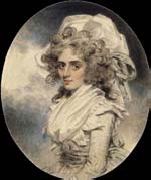 |
John Downman
|
|
English Painter, ca.1750-1824, English painter and draughtsman. He became a pupil of Benjamin West in 1768 and entered the Royal Academy Schools, London, the following year. In 1770 and 1772 he exhibited portraits at the Royal Academy and showed his first subject picture in 1773. He left for a period of study in Italy and was in Rome with Joseph Wright of Derby from 1773 to 1774. When he next exhibited at the Royal Academy (1777) he was living in Cambridge, but from 1778 to 1804 his considerable annual contribution to the Academy exhibitions was sent from various London addresses. His very popular small portraits were often shown in groups of six or nine. His occasional subject pictures were based on themes from mythology, Classical history, poetry and the theatre. They included a scene from As You Like It (untraced) painted for John Boydell's Shakespeare Gallery. Downman became ARA in 1795 and travelled widely in later life, marrying in Exeter in 1806 and sending works to the Royal Academy (1805-12 and 1816-19) from all over the country. |
|
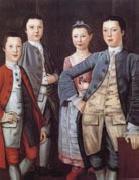 |
John Durand
|
|
American.
active1766-1782
A signed portrait (priv. col.) dated 1765 provides the first documentary information on him. He advertised in the New York Journal on 26 November 1767 that he had opened a drawing school, and again on 7 April 1768, announcing his availability as a history painter, though no examples of this activity survive. Like other painters in the colonies, he made his living from portrait painting. His most noted work, the Rapalije Children (1768; New York, NY Hist. Soc.), demonstrates the strong decorative sense, the delicate use of colour and the attempts at sophisticated value and texture application that characterize all his paintings. His skill as a draughtsman is evident in the carefully described details. Here, as in other works, he used a dark outline to define one plane from another, and he imparted a sense of elegance, particularly in the slightly turned heads and animated arms and hands. |
|
|
|
 |
john scarlett davis
|
|
John Scarlett Davis (1 September 1804 - 29 September 1845), or Davies, was an English painter of the first half of the nineteenth century.
Davis was born in Leominster, the son of James Davis, a watchmaker; Scarlett was his mother's maiden name. At the age of eleven, Davis won an award from the local society for the encouragement of the arts. He was educated at the Royal Academy of Art School in London, and began exhibiting his works at the annual Royal Academy shows in 1825. He was influenced by the work of his contemporary, Richard Parkes Bonington.
Davis painted portraits, landscapes, and church interiors, and developed a distinctive specialty in painting the interiors of art galleries. His picture The Interior of the British Institution Gallery (1829) records a collection of Old Masters. His watercolor of the collection of Benjamin Godfrey Windus (1835) shows the Turner pictures on the walls. (John Ruskin studied those Turners while writing his Modern Painters.) Davis painted the interiors of the Louvre as well. Between 1842 and 1845 he was commissioned to draw copies of the paintings in the collections of the British royal palaces.
Davis painted scenes on the Continent during his travels there. He was in Florence in 1834, and Amsterdam in 1841. He painted the interior of the Uffizi Gallery.
Davis's later years were marred by alcoholism and spells of imprisonment. His posthumous reputation suffered as a result.
Davis's name is almost identical to that of John Scarlett-Davies, a modern video artist and director. |
|
|

